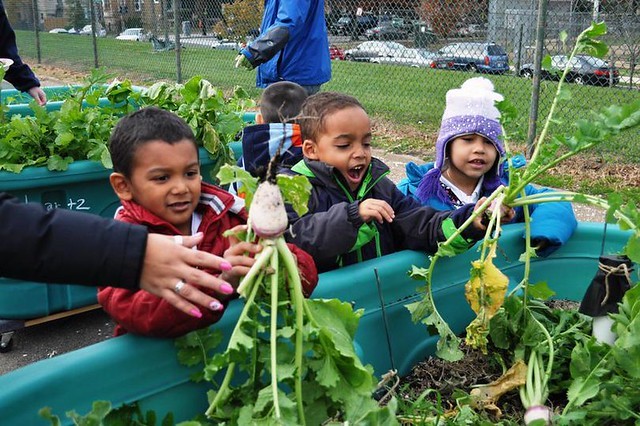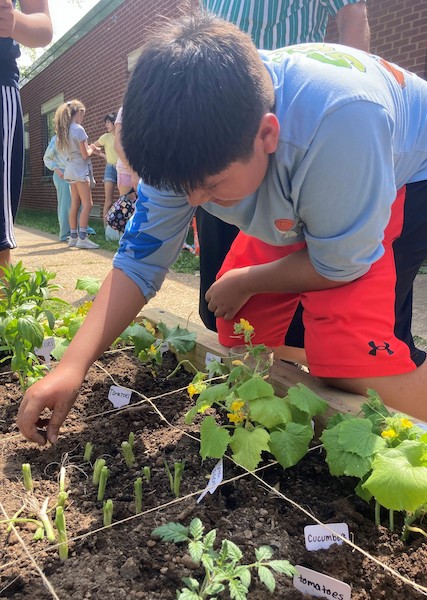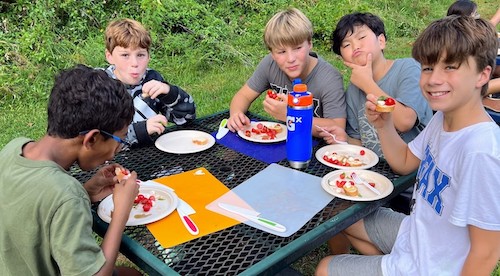School Gardens in Fairfax County
by Mark Kieffer, Fairfax Master Gardener
 School gardens have a long history in the United States beginning with a garden at the George Putnam School in Roxbury, Massachusetts in 1891. Over the years since, interest in school gardens has waxed and waned along with changing educational trends. School gardens even played a role in supporting efforts to address food shortages during the two world wars. A revival of school gardens began in the 1990s, fostered in part by Alice Waters’ Edible Schoolyard Project and Michelle Obama’s Let’s Move campaign. Interest in school gardens continues to grow with the growth of environmental education, local food movements and interest in healthier eating with school districts nationwide using gardens as educational tools in the classroom and to promote community inclusion.
School gardens have a long history in the United States beginning with a garden at the George Putnam School in Roxbury, Massachusetts in 1891. Over the years since, interest in school gardens has waxed and waned along with changing educational trends. School gardens even played a role in supporting efforts to address food shortages during the two world wars. A revival of school gardens began in the 1990s, fostered in part by Alice Waters’ Edible Schoolyard Project and Michelle Obama’s Let’s Move campaign. Interest in school gardens continues to grow with the growth of environmental education, local food movements and interest in healthier eating with school districts nationwide using gardens as educational tools in the classroom and to promote community inclusion.
Get2Green
Fairfax County Public Schools supports school gardens as part of its environmental stewardship program, Get2Green. G2G offers guidance and resources for classes and eco-teams implementing hands-on environmental action in their schools and community, including planting and maintaining wildlife habitat and edible gardens at schools. While the number of schools maintaining gardens decreased during the pandemic, a rebound is expected as interest remains high and increased funding and support for outdoor learning is available from the county and other organizations.
Nearly all FCPS schools have a designated G2G Leader responsible for forming and advising a student-driven G2G Team, conducting an environmental audit of their school and creating and implementing an action plan. Additional funding allowed hiring of four Resource Teachers to each oversee and assist the G2G Leaders at 50 schools. Other G2G program staff provide technical, educational and curriculum support and coordination with FCPS Facilities Management.
G2G provides virtual and in-person professional development opportunities for G2G leads, teachers and administrators covering subjects such as fall gardening, outdoor learning in cold weather and a program for FCPS administrative staff about the current research on the benefits of outdoor learning, including edible gardens.
G2G is providing seed money to each school to be used for any environmental stewardship related activities, with many schools using the funding to bolster their gardening programs by buying tools and supplies. Additional grant funding is being made available to schools that are having outdoor learning spaces installed on their school grounds. Designs for school renovations now include the addition of outdoor learning areas, which should increase the opportunity for edible gardens. G2G publishes a newsletter that publicizes grant opportunities that many schools have taken advantage of to augment funding for their G2G and related activities.
To address the common challenges schools experience in sustaining the continuity of school gardens, G2G is emphasizing the building of teams at each school and ways to ensure that garden upkeep doesn’t fall on one person, be it a teacher, volunteer or school staff member.
Pandemic Impact
While the pandemic caused a decrease in school garden activity, some remained active and provided places where school community members could continue to work and learn together during the pandemic. The Fairfax Food Council through its Urban Ag Working Group partnered with schools in 2021 to use school gardens to grow fresh produce for food banks in response to increased food insecurity experienced during the pandemic.
Examples of School Gardens
 W.T. Woodson High School was among the schools that used its garden space to begin growing and donating fresh produce to food banks in 2021 and 2022. The garden, comprising raised beds and pollinator beds just outside science classrooms, is run by the school Environmental Club and supported by a senior faculty mentor/advisor, who is the school G2G Leader, and a team of FCMGA mentors.
W.T. Woodson High School was among the schools that used its garden space to begin growing and donating fresh produce to food banks in 2021 and 2022. The garden, comprising raised beds and pollinator beds just outside science classrooms, is run by the school Environmental Club and supported by a senior faculty mentor/advisor, who is the school G2G Leader, and a team of FCMGA mentors.
The gardens continued to grow and prosper in 2023 with students participating in all phases of gardening — planning what to grow, starting seeds indoors, preparing soil, growing and harvesting crops from spring into the fall and planning for 2024. With guidance from Master Gardeners, students are learning about good practices such as use of cover crops, and companion and succession planting. Grants and donations of materials from various sources supported the building of additional raised beds, acquisition of garden soil and trellises for vertical growing beans and cucumbers and some additional tools.
To attract pollinators and increase biodiversity, the student gardeners introduced a wide range of herbs and flowers throughout the garden such as basil, dill, parsley, borage, Joe Pye Weed and comfrey. There is also a stand of milkweed and Black-eyed Susans to support pollinators and wildlife. The garden is used to supplement lessons in science classes.
Using indoor seed trays and growing lights in a nearby classroom, students started warm-season seeds and nurtured seedlings for transplanting to the outdoor beds. In addition, the club donated over 100 seedlings they started to Hands on Harvests, whose volunteers transplanted them to pots to share with community gardens and individuals interested in growing their own food.
This year, club members harvested and donated over 700 pounds (315 kg) of produce to Food for Others, a substantial increase from the 400 pounds (180 kg) donated in 2022. VCE contributed the scale used to weigh produce. Club members also volunteered to share their experiences with students at nearby elementary schools with gardens.
Students, with the help of their faculty advisor, implemented a twice-weekly summer volunteer program to ensure garden maintenance during the summer. Activities included watering, weeding, harvesting and weighing produce for donation to a local food bank. Master Gardener mentors were on hand to share good horticultural practices with the student gardeners. Students logged their visit notes in a shared database accessible via phones using a QR code.
For 2024, club members are discussing introduction of more heat and drought tolerant vegetable varieties and ways to control weeds without resorting to potentially harmful herbicides.

Marshall Road student planting seedlings in 6th grade legacy garden.
Marshall Road Elementary School maintains both edible and pollinator gardens using pots, raised beds and landscape beds in an inner courtyard, and behind and around the school grounds. The school Garden Educator, who is also a Master Gardener, serves as the school’s Get2Green Leader.
The G2G Leader emphasizes communication with teachers and parents and inviting parents to visit and volunteer for class garden projects. The garden is kept open for many school events, with the G2G Leader present, to publicize the garden and attract parent volunteers. To make the courtyard garden accessible to all students and staff, a new walkway was installed this year. Photos of students at work in the garden are regularly shared in garden-related articles and presentations and daily school news reports. This helps the student gardeners feel like other students and teachers are recognizing them.
The G2G Leader works closely with teachers to give every classroom the opportunity to use the gardens and integrate hands-on and observational activity in the garden with classroom instruction. For example, Soil 101 for younger students included a soil basics talk with digging and sorting while older grades learned about soil identification and ribboning. (The ribbon test is used to estimate soil texture and the amount of clay in a soil.) In another class, students learned about worms and vermicomposting using the school’s vermicomposting tower. Several classes plan to participate again in a seed starting and growing project using recycled plastic milk jugs as containers to sprout seeds over the winter for transplanting as seedlings in the spring.
Participants in the school’s Spring Garden Day added soil to four new raised beds that were built for the school by a Boy Scout for his Eagle Scout project. The 6th grade classes used the new beds for a legacy garden in which each class worked together to plan and plant a raised bed to benefit others after they left for middle school. The classes made designations about what their legacy is and to whom the fruit of their labor would be directed including produce for donation to local food banks.
To support the garden in the summer, a system was created for families to sign up for 1-week adopt-the-garden slots. The sign ups were quickly booked and volunteer families watered crops and harvested produce for their own use or donation to Food for Others. To protect and enrich the garden soil, Fall Cleanup Day included planting of cool season cover-crop seeds and adding shredded leaves.
An Audubon Society of Northern Virginia expert provided advice on native plants to add around the grounds to attract and support pollinators and create way stations for wildlife. To support implementation, the Ayr Hill Garden Club donated native seedlings purchased from native plant grower Earth Sangha.
In 2024, a new salsa garden is planned to use a grant from Virginia Agriculture in the Classroom. The idea for the garden was inspired by fresh pico de gallo and salsa made by a parent for a Hispanic Heritage event using vegetables from the school garden. Other plans include adding structures for vertical growing, a new composter and adding native plants around the school.

Willow Springs School gardeners enjoying the fruits of their labors.
The school garden at Willow Springs Elementary School started as a parent-led initiative with parent volunteers working with the school to build fenced-in raised beds, and meadow and pollinator gardens. The gardens are supported by the school STEAM educator, who is also the school G2G Leader, and the after-school garden club. The gardens have received contributions from local businesses, and a pair of dedicated retirees volunteer many hours to help maintain the gardens and support garden club activities.
Examples of how the gardens are used to supplement classroom instruction include: kindergarten students explore using their five senses in the garden and plant pumpkins; first graders grow plants to support birds; second graders plant milkweed for Monarch caterpillars so they can observe the life cycle in their classrooms; third graders learn about beneficial insects, like ladybugs, by raising them in the classroom and then releasing them to the garden; third graders do a soil study; fourth graders learn about pollination and observe the bees collecting/transferring pollen from flowers; fifth graders learn about growing and selling produce in the garden for the farmer’s market as a way to learn about consumerism and the benefits of local sourcing; and sixth graders learn about composting, and how to use Microbits (a programmable device) to monitor composting bins for efficiency.
The garden club uses produce from the garden for after-school cooking to learn how to prepare dishes with seasonal produce, for example in making zucchini bread. Parents have said that the edible garden has expanded their childrens’ palettes to eat vegetables that they previously would not touch at home.
To enhance the wildlife habitat at the school, the G2G Leader obtained a grant from the VA Bluebird Society that allowed the school to install bluebird houses with poles, pest guards and a webcam for one of the houses. A county naturalist provided advice on placement of the houses around the school grounds. Observations of bluebird activity are among the subjects recorded by students in nature journals along with other observations about what they are growing and seeing in the gardens throughout the season.
Inspired by a successful farmers market initiative at Centreville Elementary School, Willow Springs started its own farmers market working with Piney-Meadow Farm. The market, held weekly in season, is run by students and parents for students, their families and staff. Although most of the produce sold is from the farmer, students also sell produce, herbs and flowers from the school gardens. Money raised through market sales goes towards the Garden Club and STEAM activities. The market along with the students’ work in the gardens provides lessons on where the freshest foods come from and complements students’ lessons in STEAM education.
With the school scheduled for renovation beginning in Spring 2024, the edible garden will move to a new location at the school. The plans include a new interior courtyard that will serve as an outdoor classroom in the renovated school. Fourth grade students are writing proposals for design ideas for the space. Many students are advocating for a pond ecosystem surrounded by pollinator gardens and benches for sitting and enjoying nature.
Support for School Gardens
Among the many programs supporting school gardens, USDA’s Farm-to-School program awards grants to support farm to school programs that connect students to the sources of their food, and the Virginia Agriculture in the Classroom provides resources, training and support to schools, educators and volunteers to connect children to agriculture.
Prominent among local non-profit organizations providing support are Arcadia Farms and Hands on Harvests. Arcadia Farms has been very active in supporting gardens and garden education programs for schools and young people in the Route 1 corridor area of Fairfax County and holds monthly, gardening Q&A sessions for teachers that are also open to non-teachers. Hands on Harvests has active partnerships with schools providing seeds and mentoring. A growing number of schools participate in Hands on Harvests’ popular Grow-a-Row program through which fresh produce has been donated for distribution at local food banks.
Benefits of Outdoor Learning and School Gardens
Cornell University’s Garden-Based Learning Program maintains a detailed summary of the benefits of garden-based learning with links to articles, research papers and presentations, grouped by the area of benefit, including: Increased Nutrition Awareness, Higher Learning Achievements, Increased Environmental Awareness, Increased Life Skills, Improved Wellness and Building Social Connections and Community.
Resources
• The School Garden, USDA National Agricultural Library
• Creating an Edible Garden at your School, Fairfax County Public Schools (FCPS), Get2Green
• Woodson Students Farm Vegetables on School Grounds for Fairfax Families In Need, FCPS Office of
Communication and Community Relations, June 8, 2021
• Keeping it Fresh: Farmers Markets Offer FCPS Students Environmental Lessons, and Families Expanded Access
to Healthy Meals, FCPS Office of Communication and Community Relations, October 13, 2023
• School Gardens: Using Gardens To Grow Healthy Habits In Cafeterias, Classrooms, and Communities, USDA
Food and Nutrition Service, Fact Sheet